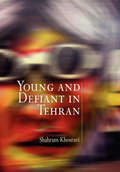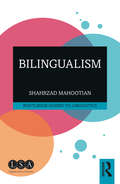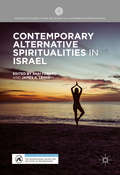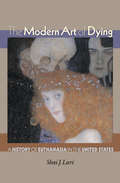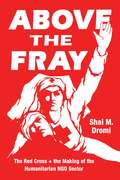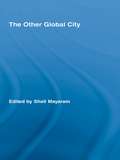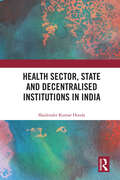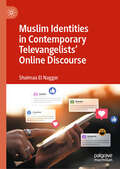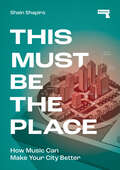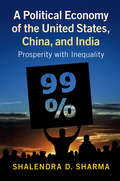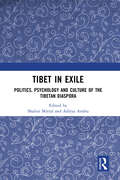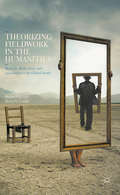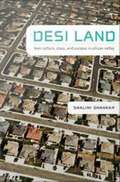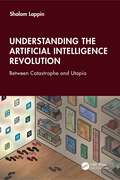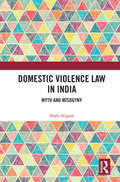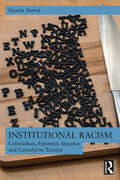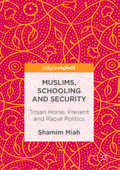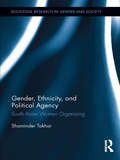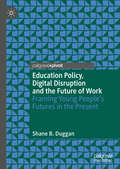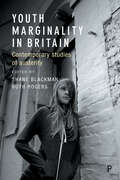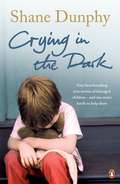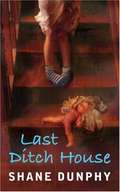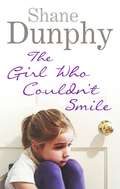- Table View
- List View
Young and Defiant in Tehran
by Shahram KhosraviWith more than half its population under twenty years old, Iran is one of the world's most youthful nations. The Iranian state characterizes its youth population in two ways: as a homogeneous mass, "an army of twenty millions" devoted to the Revolution, and as alienated, inauthentic, Westernized consumers who constitute a threat to the society. Much of the focus of the Islamic regime has been on ways to protect Iranian young people from moral hazards and to prevent them from providing a gateway for cultural invasion from the West. Iranian authorities express their anxieties through campaigns that target the young generation and its lifestyle and have led to the criminalization of many of the behaviors that make up youth culture.In this ethnography of contemporary youth culture in Iran's capital, Shahram Khosravi examines how young Tehranis struggle for identity in the battle over the right to self-expression. Khosravi looks closely at the strictures confronting Iranian youth and the ways transnational cultural influences penetrate and flourish. Focusing on gathering places such as shopping centers and coffee shops, Khosravi examines the practices of everyday life through which young Tehranis demonstrate defiance against the official culture and parental dominance. In addition to being sites of opposition, Khosravi argues, these alternative spaces serve as creative centers for expression and, above all, imagination. His analysis reveals the transformative power these spaces have and how they enable young Iranians to develop their own culture as well as individual and generational identities. The text is enriched by examples from literature and cinema and by livid reports from the author's fieldwork.
Bilingualism (Routledge Guides to Linguistics)
by Shahrzad MahootianBilingualism provides a concise and lively introduction to bilingualism as a social and linguistic phenomenon and explains its impact on individuals and on society. Addressing questions such as what it means to be bilingual, how one becomes bilingual, and how exposure to more than one language can hinder or enhance a child’s cognitive development, this book features: an introduction to the linguistic, sociolinguistic, and cognitive outcomes of bilingualism, including bilingual language acquisition, the grammar of language-mixing, the link between language choice and identity, and the value of maintaining and promoting bilingualism; up-to-date overviews of the prominent concerns and facts about bilingualism; activities and discussion questions which invite readers to consider their own perspectives on bilingualism and how it manifests in their own lives and communities; links to relevant videos and suggested further reading, including topical novels, short stories, and essays. Aimed at students with no background in linguistics, this book is essential reading for anyone studying bilingualism for the first time.
Contemporary Alternative Spiritualities in Israel (Palgrave Studies in New Religions and Alternative Spiritualities)
by Shai Feraro and James R. LewisThis volume is the first English-language anthology to engage with the fascinating phenomena of recent surges in New Age and alternative spiritualties in Israel. Contributors investigate how these New Age religions and other spiritualties—produced in Western countries within predominantly Protestant or secular cultures–transform and adapt themselves in Israel. The volume focuses on a variety of groups and movements, such as Theosophy and Anthroposophy, Neopaganism, Channeling, Women’s Yoga, the New Age festival scene, and even Pentecostal churches among African labor migrants living in Tel Aviv. Chapters also explore more Jewish-oriented practices such as Neo-Kabballah, Neo-Hassidism, and alternative marriage ceremonies, as well as the use of spiritual care providers in Israeli hospitals. In addition, contributors take a close look at the state’s reaction to the recent activities and growth of new religious movements.
The Modern Art of Dying: A History of Euthanasia in the United States
by Shai J. LaviHow we die reveals much about how we live. In this provocative book, Shai Lavi traces the history of euthanasia in the United States to show how changing attitudes toward death reflect new and troubling ways of experiencing pain, hope, and freedom. Lavi begins with the historical meaning of euthanasia as signifying an "easeful death." Over time, he shows, the term came to mean a death blessed by the grace of God, and later, medical hastening of death. Lavi illustrates these changes with compelling accounts of changes at the deathbed. He takes us from early nineteenth-century deathbeds governed by religion through the medicalization of death with the physician presiding over the deathbed, to the legalization of physician-assisted suicide. Unlike previous books, which have focused on law and technique as explanations for the rise of euthanasia, this book asks why law and technique have come to play such a central role in the way we die. What is at stake in the modern way of dying is not human progress, but rather a fundamental change in the way we experience life in the face of death, Lavi argues. In attempting to gain control over death, he maintains, we may unintentionally have ceded control to policy makers and bio-scientific enterprises.
Above the Fray: The Red Cross and the Making of the Humanitarian NGO Sector
by Shai M. DromiFrom Lake Chad to Iraq, nongovernmental organizations (NGOs) provide relief around the globe, and their scope is growing every year. Policymakers and activists often assume that humanitarian aid is best provided by these organizations, which are generally seen as impartial and neutral. In Above the Fray, Shai M. Dromi investigates why the international community overwhelmingly trusts humanitarian NGOs by looking at the historical development of their culture. With a particular focus on the Red Cross, Dromi reveals that NGOs arose because of the efforts of orthodox Calvinists, demonstrating for the first time the origins of the unusual moral culture that has supported NGOs for the past 150 years. Drawing on archival research, Dromi traces the genesis of the Red Cross to a Calvinist movement working in mid-nineteenth-century Geneva. He shows how global humanitarian policies emerged from the Red Cross founding members’ faith that an international volunteer program not beholden to the state was the only ethical way to provide relief to victims of armed conflict. By illustrating how Calvinism shaped the humanitarian field, Dromi argues for the key role belief systems play in establishing social fields and institutions. Ultimately, Dromi shows the immeasurable social good that NGOs have achieved, but also points to their limitations and suggests that alternative models of humanitarian relief need to be considered.
The Other Global City (Routledge Advances in Geography)
by Shail MayaramWhat is a Global City? Who authorizes the World Class City? This edited volume interrogates the "global cities" literature, which views the city as a shimmering, financial "global network." Through a historical-ethnographic exploration of inter-ethnic relations in the "other global" cities of Cairo, Beirut, Istanbul, Bukhara, Lhasa, Delhi, Singapore, Kuala Lumpur and Tokyo, the well-known contributors highlight cartographies of the Other Global City. The volume contends that thinking about the city in the longue duree and as part of a topography of interconnected regions contests both imperial and nationalist ways of reading cities that have occasioned the many and particularly violent territorial partitions in Asia and the world.
Health Sector, State and Decentralised Institutions in India
by Shailender Kumar HoodaThis book describes the transition in Indian healthcare system since independence and contributes to the ongoing debate within development and institutional economics on the approaches towards reform in the public health system. The institutional reform perspective focuses on examining the effective utilisation of allotted resources and improvements in delivery through decentralisation in governance by ensuring higher participation of elected governments and local communities in politics, policymaking and delivery of health services. It discusses the economic (resource) reforms to explain the relevance and expansion of state interventionism along with its influence on the health sector, accountability and allocative efficiency. The author also explores the connections between neoliberal thought and privatisation in health sector, and examines the greater role of insurance-based financing and their implications for health service access and delivery. The book offers ways to address long-standing systemic and structural problems that confront the Indian healthcare system. Based on large-scale surveys and diverse empirical data on the Indian economy, this book will be of great interest to researchers, students and teachers of health economics, governance and institutional economics, political economy, sociology, public policy, regional studies and development studies. This will be useful to policymakers, health economists, social scientists, public health experts and professionals, and government and nongovernment institutions.
Sexuality Reimagined: MSM in Modern India
by Shailja TandonThe book examines how medical knowledge is produced around bodies that do not fit in the heteronormative framework of the state’s rationale and processes. The marginal bodies studied in this research are termed MSM, men who have sex with men, categorized as a high-risk group in the backdrop of HIV/AIDS. These Queer bodies entered the registers of epidemiology and governmentality. This classification is the point of departure for the book. The book interrogates and asks how does a sexual subject become a political question? To answer this political trajectory, the book analyses the category of risk in biomedicine. It investigates how the category of risk becomes critical to the Indian state’s rationale and policies wherein, through the ambit of health and population, sexuality is managed. Unearthing the sexual politics in South Asia, the book, based on rich empirical evidence derived from the lived experiences of MSM, narrates the construction of sexual subjectivity and masculinity. The process of construction occurs in negotiation with the Indian state, bringing forth the dimension of the Indian state as a medico-legal governmentality regime and how MSM takes on the identity of a medicalized subject.
Muslim Identities in Contemporary Televangelists' Online Discourse
by Shaimaa El NaggarThis book examines the discourse of Muslim televangelism in the West, particularly looking at the emergence of 'home-grown' televangelists who grew up in the West and deliver their sermons in English, addressing audiences in contexts such as the UK and the USA. In their sermons, televangelists address topics that are relevant to the everyday life of Muslims and Muslim youth such as friendship, marriage and the misrepresentation of Islam/Muslims in mass media. This book explores contemporary Muslim televangelism and its manifestations in other forms of digital religion, including YouTube, websites and social media which mediate religious content. Using a Critical Discourse Studies approach, the author explores the power structures underpinning the popularity of Muslim televangelism, investigates the linguistic strategies used by Muslim televangelists to construct their identities online, and analyses how Islam and Muslims are represented in their sermons. This book will be of interest to religious studies, media studies, and discourse studies scholars, and to anyone interested in the topic of Islam/Muslims in the West in the contemporary age.
This Must Be the Place: How Music Can Make Your City Better
by Shain ShapiroThis Must Be the Place explores how music can make cities better.This Must Be the Place introduces and examines music&’s relationship to cities. Not the influence cities have on music, but the powerful impact music can have on how cities are developed, built, managed and governed.Told in an accessible way through personal stories from cities around the world — including London, Melbourne, Nashville, Austin and Zurich — This Must Be the Place takes a truly global perspective on the ways music is integral to everyday life but neglected in public policy.Arguing for the transformative role of artists and musicians in a post-pandemic world, This Must Be The Place not only examines the powerful impact music can have on our cities, but also serves as a how-to guide and toolkit for music-lovers, artists and activists everywhere to begin the process of reinventing the communities they live in.
A Political Economy of the United States, China, and India: Prosperity With Inequality
by Shalendra D. SharmaThe precipitous rise in global and national economic inequality, which the inexorable force of globalization promised to address with affluence and abundance for all, has returned with a vengeance. The problem of worsening socioeconomic inequality and how best to ameliorate this pernicious resurgence occupies center stage of national and international politics. This study investigates the coexistence of high rates of economic growth and unparalleled prosperity (including a review of the decline in poverty levels in China and India and many other developing countries) with rises in income and wealth inequality in the United States, China, and India.<P><P> This book examines the overall effectiveness of the measures taken by these three countries to address such anomalies, and what they should do to tackle the problem of widening inequality. This study breaks new ground by providing an original comparative analysis of the challenges facing the world's three major economies.<P> Addresses why both democratic and authoritarian governance have failed to promote more equitable development.<P> Provides nuanced insights into the roots of inequality crises.<P> Offers solutions to address global economic inequality.
Tibet in Exile: Politics, Psychology and Culture of the Tibetan Diaspora
by Shalini MittalThis book delves deep into the lived experiences of the Tibetan diaspora, offering an insightful exploration through the intersecting lenses of politics, psychology, and culture. Drawing from the expertise of scholars in fields such as political science, sociology, psychology, and cultural studies, the book provides a rich, multidisciplinary analysis that reveals the complexities of Tibetan life in exile. It meticulously examines the delicate diplomacy between the Tibetan government-in-exile and host nations, unraveling the intricate political dynamics that shape the aspirations and challenges faced by Tibetans abroad. In addition to political analysis, the book sheds light on the psychological resilience and cultural innovation within the Tibetan community. Through an exploration of art, music, literature, and religious practices, it uncovers how Tibetans have creatively reimagined and redefined their cultural identity in the face of displacement and adversity. This volume is an essential resource for students, researchers, and educators in anthropology, political science, sociology, psychology, and cultural studies. It also serves as a valuable tool for policymakers, advocates, and activists engaged in issues of diaspora, migration, human rights, and social justice. For anyone seeking to understand the profound impact of exile, the endurance of cultural identity, and the strength of community, this book is a must-read. This version aims to be more engaging while clearly defining the book’s scope, relevance, and target audience.
Theorizing Fieldwork in the Humanities: Methods, Reflections, and Approaches to the Global South
by Shalini Puri and Debra A. CastilloThis volume, the first of its kind, launches a conversation amongst humanities scholars doing fieldwork on the global south. It both offers indispensable tools and demonstrates the value of such work inside and outside of the academy. The contributors reflect upon their experiences of fieldwork, the methods they improvised, their dilemmas and insights, and the ways in which fieldwork shifted their frames of analysis. They explore how to make fieldwork legible to their disciplines and how fieldwork might extend the work of the humanities. The volume is for both those who are already deeply immersed in fieldwork in the humanities and those who are seeking ways to undertake it.
Desi Land: Teen Culture, Class, and Success in Silicon Valley
by Shalini ShankarDesi Land is Shalini Shankar's lively ethnographic account of South Asian American teen culture during the Silicon Valley dot-com boom. Shankar focuses on how South Asian Americans, or "Desis," define and manage what it means to be successful in a place brimming with the promise of technology. Between 1999 and 2001 Shankar spent many months "kickin' it" with Desi teenagers at three Silicon Valley high schools, and she has since followed their lives and stories. The diverse high-school students who populate Desi Land are Muslims, Hindus, Christians, and Sikhs, from South Asia and other locations; they include first- to fourth-generation immigrants whose parents' careers vary from assembly-line workers to engineers and CEOs. By analyzing how Desi teens' conceptions and realizations of success are influenced by community values, cultural practices, language use, and material culture, she offers a nuanced portrait of diasporic formations in a transforming urban region. Whether discussing instant messaging or arranged marriages, Desi bling or the pressures of the model minority myth, Shankar foregrounds the teens' voices, perspectives, and stories. She investigates how Desi teens interact with dialogue and songs from Bollywood films as well as how they use their heritage language in ways that inform local meanings of ethnicity while they also connect to a broader South Asian diasporic consciousness. She analyzes how teens negotiate rules about dating and reconcile them with their longer-term desire to become adult members of their communities. In Desi Land Shankar not only shows how Desi teens of different socioeconomic backgrounds are differently able to succeed in Silicon Valley schools and economies but also how such variance affects meanings of race, class, and community for South Asian Americans.
Understanding the Artificial Intelligence Revolution: Between Catastrophe and Utopia
by Shalom LappinAfter many years during which it languished in relative obscurity, in remote classrooms of computer science departments and in small prototype projects for tech companies, artificial intelligence (AI) is now a searingly hot topic across the media. Yet much of the public discussion is so feverish that an understanding of the basic scientific and engineering elements of the field is easily lost, often resulting in exaggerated claims, as well as dangerously neglected threats.This concise and sober book presents a brief history of AI, explaining in clear language the central engineering innovations that have produced the current revolution. It distinguishes between imagined dangers and the very real problems that AI is creating. Spread across seven short and accessible chapters, this book explains the developments behind deep learning and the applications of deep neural networks (DNNs). It addresses both the imagined and actual risks posed by the AI revolution, before outlining the elements of a rational public policy on AI, covering topics like tech monopolies, disinformation, bias, hate speech, intellectual property rights, and inequality.Suitable for the general reader, Understanding the Artificial Intelligence Revolution: Between Catastrophe and Utopia is the ideal book for anyone seeking a clear and informed introduction to AI.
Domestic Violence Law in India: Myth and Misogyny
by Shalu NigamThis book examines the prevailing legal discourse surrounding domestic violence law in India. It investigates the myths, patriarchal stereotypes, and misconceptions that undermine the process of justice and dilute legal provisions to the detriment of survivors. The volume: Develops arguments based on legal case studies and draws extensively on knowledge from various fields of study, as well as the experience of women survivors. Examines fallacies within the legal framework through a study of strategic lawsuits against public participation suits within the Indian context. Proposes measures for a fair and more gender inclusive legal system that focuses on facilitating access to justice. Suggests that emphasis be laid on establishing the rule of law and eliminating the culture of violence. A key text on gender and law in India, this book will be indispensable to scholars and researchers of socio-legal studies, law, gender, human rights, women’s studies, social science, political science, and feminist jurisprudence in South Asia. It will also be of interest to NGOs, activists, and lawyers.
Institutional Racism: Colonialism, Epistemic Injustice and Cumulative Trauma
by Shamila AhmedInstitutional Racism explores the role of colonialism, truth, and knowledge in creating and maintaining institutional racism. It documents how the manipulation of truth and knowledge facilitated colonialism and epistemicide to create a perpetrator perspective of institutional racism that maintains the illusionary status of equality and justice and continues to conceal the breadth and depth of victimisation.The chapters present an understanding of how epistemicide, critical race theory, post-colonialism, white racial frames, white privilege, and insidious trauma can be used to critique the discourses and mechanisms that sustain a perpetrator perspective of institutional racism and how these concepts facilitate a victim perspective of institutional racism that documents the cumulative psychological and physical harms of institutional racism. The second half of the book provides grounded case studies of institutional racism in the areas of education, policing, the war on terror, and Covid 19 to demonstrate how contemporary processes of colonialism and epistemicide maintain and reinforce institutional racism to negatively impact physical and mental health and contribute to cumulative trauma.This book will be of great interest to students and scholars of criminology, sociology, criminal justice, history, law, and politics, and those studying race, ethnicity, and racism, as well as anyone interested in learning about racism, structural inequality, and institutional racism.
Muslims, Schooling and Security: Trojan Horse, Prevent and Racial Politics
by Shamim MiahThis book focuses on the recent educational policy debates surrounding Muslims, schooling and the question of security in light of the Counter Terrorism Security Act – which has made ‘Prevent’ a legal duty for schools, colleges and universities. The book examines the infamous ‘Trojan Horse’ affair in Birmingham, and critically evaluates the security discourses in light of theoretical insights from the study of racial politics. The sociology of race and schooling in the UK has long been associated with a number of diverse areas of study, including racial inequality, multiculturalism, citizenship and identity; however, until very recently, very little attention has been given to securitization and race within the context of education and even less focus has been given to the links between the question of security and racial politics. This book makes a much-needed and timely contribution to debates on the complex relationship between racial politics and schooling, and will make compelling reading for students and researchers in the fields of education and sociology, as well as education policy makers.
Gender, Ethnicity and Political Agency: South Asian Women Organizing (Routledge Research in Gender and Society #35)
by Shaminder TakharThis book examines how South Asian women’s collective agency is operationalized through civic organizations in the UK. Drawing on black feminist theory and third world feminism, it shows the complexity of political agency and its relationship to identity and subjectivity, and uses empirical research to demonstrate how women are empowered to resist domination. The historically racialized image of the South Asian woman as lacking in political agency is challenged through their long history of activism on the Indian subcontinent. The creation of "critical spaces" by South Asian women in the diaspora places them as active agents who have successfully influenced social policy on important issues such as forced marriage, domestic violence and sexuality. The engagement with the empirical data demonstrates the significance and impact of race, racism, sexism and religion on the lives of the women. The book brings to the fore the pursuit of equality, rights and justice, including multiculturalism and the often debated emancipatory role of religion.
Transforming Social Action into Social Change: Improving Policy and Practice
by Shana CohenCohen offers a new framework for analyzing social projects and local social activism. Rather than look at how single projects are designed and managed to evaluate their impact, the approach calls for analyzing fields of social action: policy and politics, institutional behavior, social networks among policymakers and practitioners, and availability of funding and other resources. Combined, they affect the conceptualization of a social problem and the design and practice of social intervention. More broadly, through circumscribing the range of thinking about social problems, they delimit possibilities to generate social change. Analyzing fields also allows for linking macro-level trends in areas like policy to decision-making within individual organizations and the effectiveness of projects at instigating the desired transformation in individual and collective behavior. Working together, policymakers, individual activists, nonprofit organizations, and staff in public institutions like schools and hospitals can critique and alter fields to challenge more effectively social problems. This collaboration, in turn, affects how social policies are designed and, ultimately, the politics of social change.
Education Policy, Digital Disruption and the Future of Work: Framing Young People’s Futures in the Present
by Shane B. DugganThis book examines the possibilities, practices and consequences of digital disruption and networked economies in education policy. As traditional notions of learning and labour are abstracted by networked technologies, young people are exposed to new forms of governance and intervention. Tracing key education policy shifts from the turn of the millennium to the present day, this book explores notions of value, aspiration, and equity in the context of the rise of the networked economies and the ‘end of work’. It argues that a policy focus on preparing young people for the future – a future that will be dominated by networked technologies – informs both what counts as ‘success', and reorganises young people’s orientation in the present in new commodified forms. In an era where the costs of higher education are rapidly increasing despite their relative decline in value, this book will resonate with scholars in youth and educational studies, as well as those with an interest in emerging forms of labour and work.
Youth Marginality in Britain: Contemporary Studies of Austerity
by Shane Blackman and Ruth RogersTabloid headlines such as ‘Anti-social Feral Youth,’ ‘Vile Products of Welfare in the UK’ and ‘One in Four Adolescents is a Criminal’ have in recent years obscured understanding of what social justice means for young people and how they experience it. Youth marginality in Britain offers a new perspective by promoting young people’s voices and understanding the agency behind their actions. It explores different forms of social marginalisation within media, culture and society, focusing on how young people experience social discrimination at a personal and collective level. This collection from a wide range of expert contributors showcases contemporary research on multiple youth deprivation of personal isolation, social hardship, gender and ethnic discrimination and social stigma. With a foreword from Robert MacDonald, it explores the intersection of race, gender, class, asylum seeker status and care leavers in Britain, placing them in the broader context of austerity, poverty and inequality to highlight both change and continuity within young people’s social and cultural identities. This timely contribution to debates concerning youth austerity in Britain is suitable for students across youth studies, sociology, education, criminology, youth work and social policy.
Crying in the Dark
by Shane DunphyFour extraordinary true stories ... Bobby and Micky, six and four, controlled from beyond the grave by their evil father ... Mina, seventeen, who has Downs Syndrome, desperate to be like everyone else, falling into the hands of men who abuse her trust ... Sylvie, a fourteen-year-old mother being pimped by her father ... Twins Larry and Francey, ten, scarcely human after an upbringing of savage and unimaginable cruelty ... One inspiring account of how one man got to know these wounded children and tried to give them hope - and a future.
Last Ditch House
by Shane DunphyThe cases recounted here by the author-- a child protection worker, are those of four children from very different aspects of Irish society, each with a unique story to tell.
The Girl Who Couldn't Smile
by Shane DunphyWhen Shane Dunphy starts work at Little Scamps crèche, he has no idea what he has let himself in for. He had not worked in an early years setting for many years and on arriving for his first day he found that two members of staff, Susan and Tush, are at the end of their tether and on the verge of resigning. The children themselves are completely out of control. At the centre of this chaos Shane finds Tammy, a pretty, doll-like five-year-old who is a mystery to everyone: she does not talk, or even smile, yet shows signs of remarkable intelligence.Through the course of the year, Shane attempts to bring order to this motley group and we learn the stories of some of the other children in the crèche: Milandra, an angry, violent four year old, the daughter of a Nigerian father and Irish mother; Rufus, a gypsy child who is direly neglected; Julie, a tiny, painfully shy little girl with Down's Syndrome. How is Shane ever to find a way to communicate with and ultimately befriend such diverse and challenging personalities? Then one afternoon, Gus, the class tear away, receives the gift of a blue crayon - a crayon he claims is magic. And Shane begins to wonder if this magic could be the answer to all his problems ... Shane Dunphy's moving portrait of a year at Little Scamps is a testament to the redemptive power of love and nurturing, of finding oneself through the care of others, as well as finding the secret of a girl who couldn't smile.
